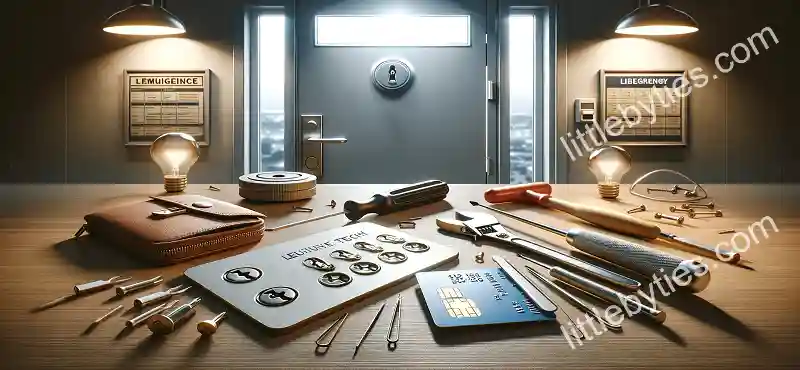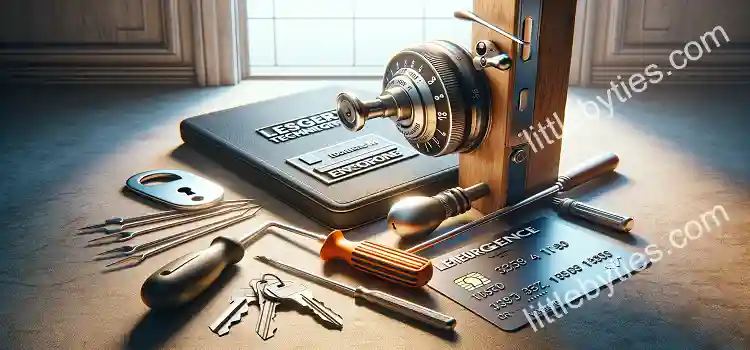Getting locked out of your home or room is a common and frustrating mishap that can happen to anyone. It can be a safety concern, especially in emergencies. Knowing how to unlock a door without a key is a valuable skill that can save you time, stress, and money from calling a locksmith. It’s best to use non-destructive methods to avoid damaging your door or lock, keeping your home safe and avoiding extra repair costs. The goal is to re-enter your space smoothly and safely, so stay calm, find a solution, and get that door open.
Understanding Door Lock Mechanisms

Door locks are like puzzles. They keep our homes safe. Most locks have a keyhole where you insert the key. Turn the key, and the lock’s pins move, allowing the door to open. It’s a simple yet clever way to keep doors secure.
In homes, you’ll often find two types of locks. The first is the knob lock, usually on bedroom or bathroom doors. It has a knob you turn to lock and unlock from the inside. The second type is the deadbolt, found on front doors. It’s stronger and provides more security. You need a key to open it from the outside.
How to unlock a door without a key: Non-Destructive Methods
Here are some non-destructive methods to unlock doors, ensuring you can regain entry without causing damage:
1. Using a Plastic Card
- Ideal for: Spring latch locks commonly found on interior doors.
- How to do it: Slide a plastic card (like a gift card) between the door frame and the latch. Tilt and wiggle the card to push the latch back into the door and open it.
- Considerations: Avoid using important cards like credit cards as they may get damaged.
2. Lock Picking with Improvised Tools
- Ideal for: Pin tumbler locks.
- How to do it: Use a bobby pin or paperclip as a makeshift lock pick. Straighten the pin, insert it into the lock, and gently rake it to set the pins one by one.
- Considerations: Only attempt on your own locks to avoid legal issues. It requires practice and patience.
3. Using a Professional Lock Pick Set
- Ideal for: Various types of locks.
- How to do it: Use the tension wrench to apply pressure and the pick to set the pins. It’s about feeling the pins and setting them above the shear line.
- Considerations: Owning lock picks may be regulated in some areas. Ensure it’s legal in your location and used responsibly.
4. Bumping the Lock
- Ideal for: Pin tumbler locks.
- How to do it: Insert a specially cut bump key into the lock and then ‘bump’ it with a mallet or screwdriver handle to align the pins.
- Considerations: Bump keys must match the lock type. This method should be used sparingly as it can damage older or weaker locks.
5. Removing the Door Knob
- Ideal for: When you have access to the screws holding the door knob.
- How to do it: Unscrew and remove the knob, then manually retract the mechanism holding the door closed.
- Considerations: This method is more intrusive and should be a last resort for interior doors.
6. Using a Knife or Similar Tool
- Ideal for: Simple latch locks.
- How to do it: Use a butter knife or a similar blunt tool to push back the latch. Slide it between the door and the frame, then wiggle and push against the latch.
- Considerations: Choose a tool that’s sturdy but won’t damage the door or hurt you.
General Tips:
- Stay Calm: Panic can make the situation worse. Take deep breaths and assess your options.
- Assess the Lock: Understand the type of lock you’re dealing with and choose the method accordingly.
- Be Gentle: Applying too much force can damage the lock or door, making the situation worse.
- Legal and Ethical Considerations: Ensure you’re legally allowed to pick the lock, and it’s ethically right (i.e., it’s your property or you have permission).
how to unlock a door without a key: Destructive Entry Methods
Destructive entry methods might be considered as a last resort. These methods will damage the lock or door and should only be used in critical situations.
1. Drilling the Lock
- When to consider: Use this method only if all non-destructive methods fail and you need urgent access.
- Step-by-step guide:
- Choose the right drill bit: Use a strong, durable bit.
- Position the drill: Aim at the keyhole, slightly above where the key’s teeth would be.
- Start drilling: Apply steady pressure. The goal is to break the pins inside.
- Turn the lock: Once the resistance stops, use a screwdriver to turn the lock and open the door.
- Consequences and follow-up:
- Lock replacement: The lock will be destroyed and need replacing.
- Security risk: Your door will be unlocked until you replace the lock.

2. Breaking the Door
- Situations to consider: Only if you’re in an emergency, like a fire or medical issue.
- Safest way to break a door:
- Check the door type: Solid wood doors are harder to break than hollow ones.
- Aim for the lock area: This is often the weakest part.
- Use a heavy object: A hammer or a heavy boot can be used to strike.
- Strike near the lock: Hit hard but be mindful of your safety.
- Understanding costs and repairs:
- Expensive: Breaking a door can lead to costly repairs.
- Time-consuming: Replacing or repairing a door takes time.
Important Considerations
- Last resort: These methods should only be used in extreme situations.
- Safety first: Ensure your safety and the safety of others around you.
- Legal implications: Understand the legal consequences, especially if the property isn’t yours.
- Professional help: Consider calling professionals if possible, as they can handle the situation with less damage.
Professional Help: When and How to Call a Locksmith
When you’re locked out or have a lock-related issue, sometimes the best course of action is to call a professional locksmith. Here’s a guide on when and how to seek professional help:
When to Call a Locksmith
- Persistent Lockout: If you’ve tried all non-destructive methods and still can’t get in, it’s time to call a locksmith.
- Damaged or Broken Lock: If your lock is damaged or broken, a locksmith can repair or replace it.
- Lost Keys: If you’ve lost your keys, a locksmith can create a new set or rekey your locks for security.
- Security Upgrade: For upgrading your home security with new locks or a more complex system, a professional is needed.
- Emergency Situations: In emergencies where safety is a concern, a locksmith can provide quick access.
What to Expect in Terms of Cost and Services
- Service Range: Expect services like unlocking doors, cutting new keys, installing new locks, and providing security advice.
- Cost: Costs can vary widely based on the service, time of day, and difficulty. Emergency and after-hours services usually cost more. Always ask for an estimate first.
- No Surprises: A reputable locksmith will explain the issue, how they plan to fix it, and provide a clear cost before starting work.
Verifying the Credibility of Locksmith Services
- Look for Recommendations: Ask friends or family for locksmiths they’ve used and were happy with.
- Check Reviews and Ratings: Look at online reviews and check ratings on trusted platforms.
- Verify Credentials: Ensure the locksmith is licensed and insured. This protects you and your property.
- Identification: A professional locksmith should arrive in a marked vehicle and be willing to show identification and certification.
- Get a Written Estimate: Before work begins, make sure you have a clear written estimate including the cost of parts and labor.
Conclusion
Understanding how to unlock a door without a key is invaluable, offering peace of mind in lockout situations. From non-destructive methods like using plastic cards to professional locksmith services, this guide covers various techniques ensuring safe and legal entry. Remember, while DIY methods are handy, professional help guarantees security and efficiency. Stay prepared, understand your options, and ensure you’re never left out in the cold.
Ikram Ullah is a seasoned content writer and editor hailing from Faisalabad, Pakistan, boasting a decade of rich experience in SEO and content writing. He is particularly distinguished in the realm of technology content writing, where he excels at demystifying complex technological concepts, making them accessible and engaging for a broad audience. Throughout his career, Ikram has made significant contributions to various websites, showcasing his commitment to technological advancements and his skill in creating informative and compelling content. His portfolio includes work for littlebyties.com, republicansunited.com, and invisiblelocs.net, each reflecting his dedication and expertise in the field.